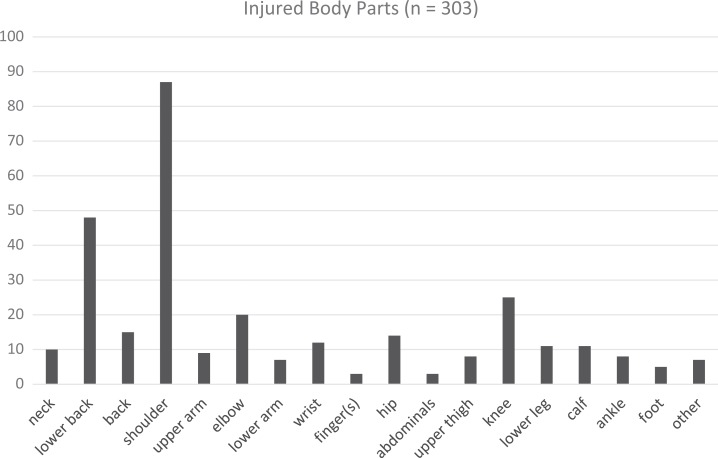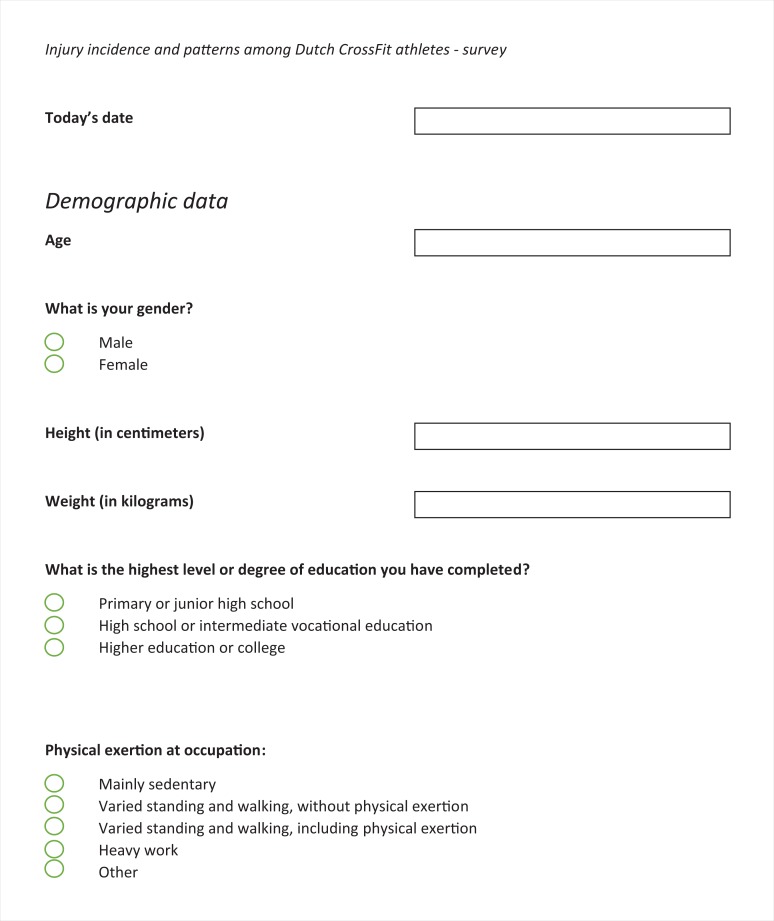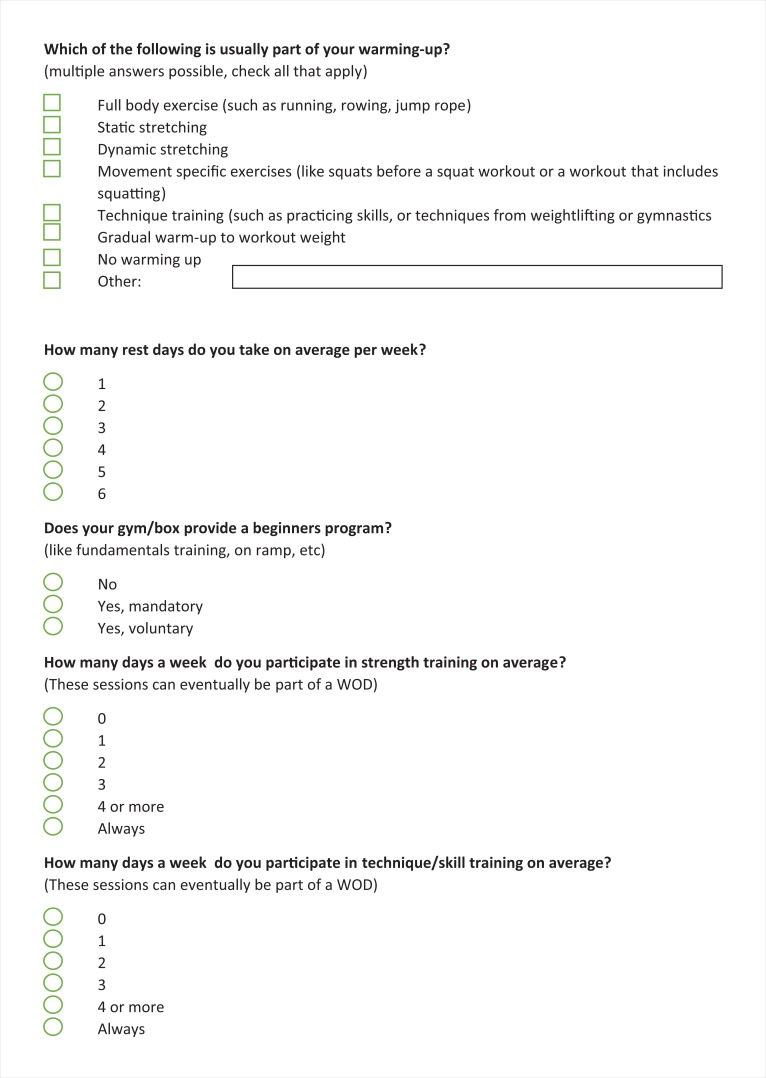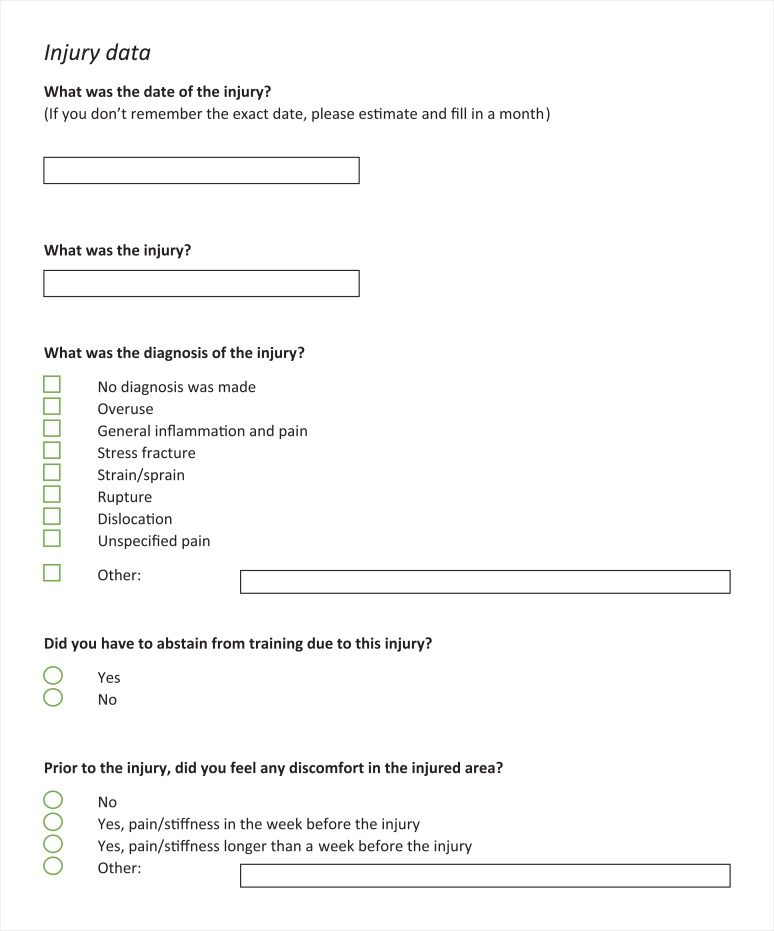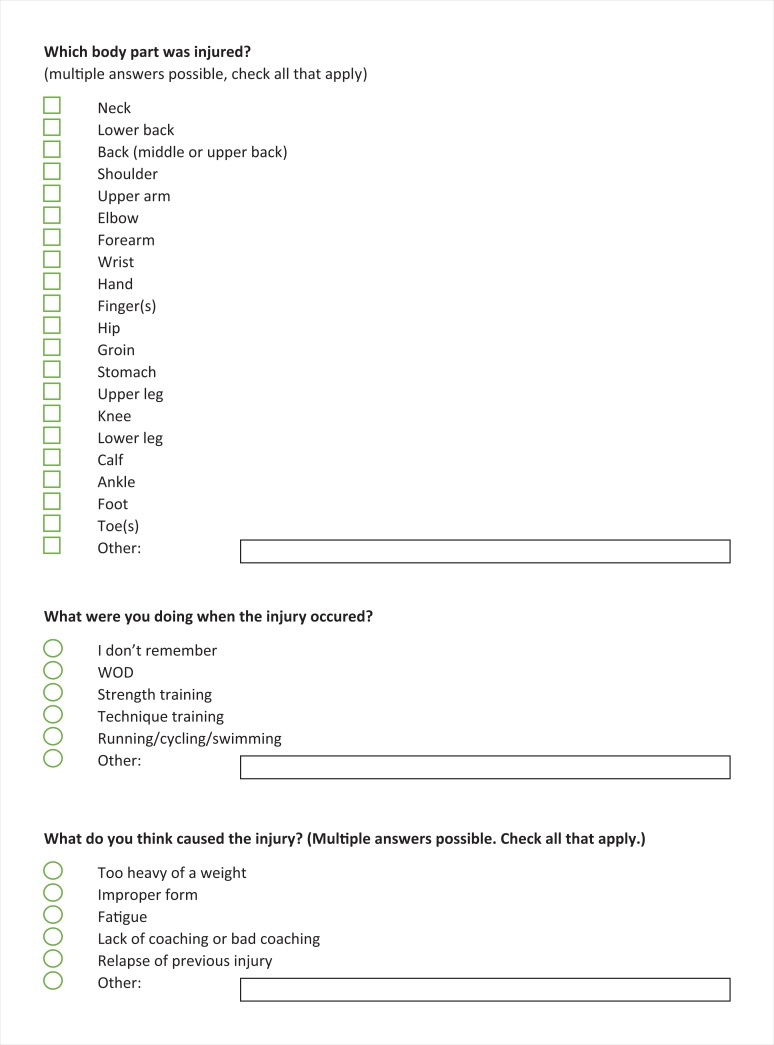Abstract
Background:
CrossFit is a strength and conditioning program that has gained widespread recognition, with 11,000 affiliated gyms worldwide. The incidence of injuries during CrossFit training is poorly analyzed.
Purpose:
To investigate the incidence of injuries for persons participating in CrossFit. Risk factors for injury and injury mechanisms were also explored through athlete demographics and characteristics.
Study Design:
Descriptive epidemiology study.
Methods:
A questionnaire that focused on injury incidence in CrossFit in the past year and included data on athlete demographics and characteristics was distributed to all 130 CrossFit gyms in the Netherlands and was also available online in active Facebook groups. Data were collected from July 2015 to January 2016. Inclusion criteria consisted of age ≥18 years and training at a registered CrossFit gym in the Netherlands. A total of 553 participants completed the survey. Univariable and multivariable generalized linear mixed models were used to identify potential risk factors for injury.
Results:
A total of 449 participants met the inclusion criteria. Of all respondents, 252 athletes (56.1%) sustained an injury in the preceding 12 months. The most injured body parts were the shoulder (n = 87, 28.7%), lower back (n = 48, 15.8%), and knee (n = 25, 8.3%). The duration of participation in CrossFit significantly affected the injury incidence rates (<6 months vs ≥24 months; odds ratio, 3.687 [95% CI, 2.091-6.502]; P < .001). The majority of injuries were caused by overuse (n = 148, 58.7%).
Conclusion:
The injury incidence for athletes participating in CrossFit was 56.1%. The most frequent injury locations were the shoulder, lower back, and knee. A short duration of participation (<6 months) was significantly associated with an increased risk for injury.
Keywords: CrossFit, competitive exercise, fitness, injury rate, weightlifting
CrossFit defines itself as a “constantly varied, high intensity, functional movement” strength and conditioning program. The aim of the sport is to forge broad, general, and inclusive fitness, preparing its trainees for any physical contingency.12 Since its invention in the year 2000, CrossFit has seen a rising popularity with over 11,000 affiliated gyms worldwide and has gained widespread recognition. There are approximately 130 registered CrossFit gyms in the Netherlands with approximately 15,000 athletes. There are also unregistered gyms that offer CrossFit but do not meet the instructor requirements and do not pay the license to use the name “CrossFit.”8 The number of unregistered gyms and participants is unknown.
Typical exercises include a wide variety of sports, ranging from Olympic weightlifting to running and rowing, kettlebells and other odd-shaped objects, gymnastics, and powerlifting.
The program is usually formed by “workouts of the day” (WODs). WODs are designed to include functional movements in various patterns executed at high intensity. Each WOD can be scaled to allow participation regardless of strength and fitness levels. CrossFit has been adopted in both military and civilian populations, with widespread reports of fitness and other health-related gains, and has been shown to improve physical fitness in a heterogeneous group of people.9,18,22,25
Incidence data of injuries during CrossFit training are sparse.17 Two observational studies have examined the injury rate in CrossFit and suggest that it is similar to other sports and exercise programs.13,29 However, both studies have been criticized because of their methodological limitations. Therefore, accurate data on the injury prevalence, rates, and patterns among CrossFit athletes are needed.1–4 CrossFit has been criticized as having a potentially disproportionate risk of musculoskeletal injury, and research on injury rates and risk factors for injury are recommended.5,17
The injury rates from the various sports that are blended into CrossFit are known6,7,15,16,20,23,24; however, they cannot be applied to CrossFit because of the combination that is used compared with the single modality form of the original sport. Analyzing injury rates and patterns for CrossFit is the first step of injury prevention during CrossFit training, as described in the “injury prevention model.”28
Therefore, this study aimed to investigate the incidence of injuries for athletes participating in CrossFit. Potential risk factors for injury and injury mechanisms were also explored as a secondary aim.
Methods
Study Design
Study data were collected via an electronic survey using SurveyMonkey from July 2015 to January 2016 and hosted at the Department of Orthopaedics, Reinier de Graaf Gasthuis, Medical Centre Delft. The study protocol was assessed by the regional medical ethics committee, and no ethics approval was necessary because it did not fall under the scope of the Medical Research Involving Human Subjects Act.
A musculoskeletal injury was defined as applied in prior research29: any new musculoskeletal pain, feeling, or discomfort as a result of a CrossFit workout that met 1 of the following criteria:
Total removal from CrossFit training and other outside routine physical activities for >1 week.
Modification of normal training activities in duration, intensity, or mode for >2 weeks.
Any physical complaint severe enough to warrant a visit to a health professional.
Data Collection
All CrossFit gym owners in the Netherlands were identified through maps.crossfit.com (which has an overview of all registered and affiliated CrossFit gyms) and were sent a link to our online survey via email. There are approximately 130 CrossFit gyms in the Netherlands. We asked each gym to encourage their members to complete the online survey. We also posted a link to the online survey in the active Facebook group “CrossFit Nederland.” All adult athletes training at a CrossFit gym in the Netherlands were invited to participate in our study by completing the online survey. Participation was voluntary, and participants were informed that completion of the survey implied their consent to participate.
Inclusion criteria were age ≥18 years and training at a CrossFit gym in the Netherlands. Exclusion criteria consisted of training independently outside of a CrossFit gym and training at a CrossFit gym outside the Netherlands.
Participants completed a single survey (see the Appendix), which focused on the incidence of musculoskeletal injuries during CrossFit training in the preceding year and any injuries sustained during CrossFit training in the past. The survey was based on the study by Weisenthal et al,29 which assessed injury rates and patterns among CrossFit athletes in the United States. Athlete demographics and characteristics were also obtained.
Statistical Analysis
Injury data were reported based on athlete demographics and characteristics. The associations between each variable and injury during CrossFit training were examined using logistic regressions and univariable analyses to estimate the odds ratios (ORs). The outcome variable of the logistic regressions was dichotomous: injury versus no injury. Factors determined to be associated with the outcome via univariable analyses (P < .10) were included in a multivariable logistic regression. Risk factors found to be significantly associated with injury in prior research13,29 were also included in the multivariable logistic regression. In the multivariable regression, P < .05 was considered statistically significant. Statistical analyses were performed using SPSS Statistics version 24 (IBM Corp).
Results
Athlete Demographics and Characteristics
A total of 553 athletes completed the survey, of whom 449 met the inclusion criteria. Figure 1 provides a flowchart of potentially eligible participants in the study, and Table 1 provides the demographic data of the 449 included athletes. The majority of our study population achieved higher education or college (n = 326, 72.6%), and 183 (40.8%) respondents had sedentary jobs.
Figure 1.
Study flowchart with inclusion and exclusion criteria and the number of participants included.
TABLE 1.
Demographic Profile
| Sex, n (%) | |
| Male | 266 (59.2) |
| Female | 183 (40.8) |
| Age, mean ± SD, y | 31.9 ± 8.3 |
| Height, mean ± SD, cm | 177.0 ± 9.2 |
| Weight, mean ± SD, kg | 76.8 ± 12.8 |
| Body mass index, mean ± SD, kg/m2 | 24.4 ± 2.8 |
| Level of education, n (%) | |
| Higher education or college | 326 (72.6) |
| High school or intermediate vocational education | 100 (22.3) |
| Primary or junior high school | 23 (5.1) |
| Physical exertion at occupation, n (%) | |
| Mainly sedentary | 183 (40.8) |
| Varied standing and walking without physical exertion | 114 (25.4) |
| Varied standing and walking including physical exertion | 100 (22.3) |
| Heavy work | 36 (8.0) |
| Other | 16 (3.6) |
Athlete characteristics are shown in Table 2. Approximately 20% of our study population consisted of beginners, with a duration of participation in CrossFit of less than 6 months (n = 88, 19.6%). Training sessions lasted 30 to 60 minutes for most participants (n = 249, 55.5%). The majority of the included CrossFit gyms provided a beginners’ program (n = 397, 88.4%), which was mandatory for the majority of participants (n = 314, 79.1%) and sometimes voluntary (n = 83, 20.9%).
TABLE 2.
Athlete Characteristicsa
| Time participating in CrossFit, n (%) | |
| 0-6 mo | 88 (19.6) |
| 6-12 mo | 98 (21.8) |
| 12-24 mo | 128 (28.5) |
| ≥24 mo | 135 (30.1) |
| Training multiple times a day, n (%) | |
| Yes | 148 (33.0) |
| No | 301 (67.0) |
| Training, d/wk | |
| Mean ± SD | 3.9 ± 1.3 |
| Median (range) | 4 (1-7) |
| Strength training, d/wk | |
| Mean ± SD | 2.7 ± 1.1 |
| Median (range) | 3 (0-5) |
| Skill/technique training, d/wk | |
| Mean ± SD | 2.4 ± 1.2 |
| Median (range) | 2 (0-5) |
| Mobility training, d/wk | |
| Mean ± SD | 2.4 ± 1.6 |
| Median (range) | 2 (0-5) |
aSessions of strength, skill/technique, or mobility training were eventually part of a larger workout of the day.
Injury Characteristics
Of all respondents, 252 athletes (56.1%) sustained an injury in the preceding 12 months. A total of 68 athletes (15.2%) sustained ≥2 injuries (Table 3). The most injured body parts were the shoulder (n = 87, 28.7%), lower back (n = 48, 15.8%), and knee (n = 25, 8.3%) (Figure 2). Injuries were most frequent during WODs (n = 100, 39.7%); other times of injury included during strength training (n = 54, 21.4%), skill training (n = 23, 9.1%), condition training (n = 10, 4.0%), or unknown (n = 42, 16.7%).
TABLE 3.
Injuries in the Preceding 12 Months
| No. of Injuries | n (%) |
|---|---|
| 0 | 197 (43.9) |
| 1 | 184 (41.0) |
| 2 | 56 (12.5) |
| ≥3 | 12 (2.7) |
Figure 2.
Injury frequency by body part injured.
Medical professionals diagnosed 77.4% (n = 195) of all injuries, the majority of which were reported as chronic/overuse in nature (n = 148, 58.7%). We asked the athletes what they thought might have caused their injury; possible causes included bad/incorrect form (n = 75, 20.5%), fatigue (n = 74, 20.2%), too heavy of weight (n = 59, 16.1%), unknown (n = 37, 10.1%), relapse of an old injury (n = 34, 9.3%), and too little or bad coaching (n = 6, 1.6%). The majority of athletes reported that they did not feel any discomfort, pain, or stiffness in the week before the injury (n = 149, 59.1%).
Injury Rate Analysis
Results of the univariable and multivariable models are presented in Table 4. All variables with P < .10 were used for the multivariable analysis, which included age (increasing) (OR, 0.979 [95% CI, 0.947-0.992]; P = .009), duration of participation in CrossFit for 0 to 6 months (OR, 3.687 [95% CI, 2.091-6.502]; P < .001), and sports activities in addition to CrossFit (OR, 1.172 [95% CI, 0.995-1.381]; P = .058). We also added sex to the multivariable analysis because of its significance in prior research. After performing a step-by-step backward model for the multivariable analysis, duration of participation in CrossFit for 0 to 6 months was the only independent risk factor for injury (OR, 3.687 [95% CI, 2.091-6.502]; P < .001).
TABLE 4.
Univariable Analysis
| Characteristic | Injured, n | Odds Ratio (95% CI) | P Value | |
|---|---|---|---|---|
| Yes | No | |||
| Age,a y | 0.979 (0.947-0.992) | .009 | ||
| Sexb | ||||
| Female | 95 | 88 | 1 | |
| Male | 157 | 109 | 0.749 (0.513-1.095) | .136 |
| Body mass index, kg/m2 | 0.961 (0.899-1.027) | .243 | ||
| Physical exertion at job | ||||
| Mainly sedentary | 106 | 80 | 1 | |
| Standing and walking but no physical exertion | 66 | 50 | 1.004 (0.628-1.603) | .987 |
| Standing and walking including lifting and carrying | 60 | 42 | 0.928 (0.568-1.513) | .763 |
| Heavy work | 20 | 25 | 1.656 (0.860-3.191) | .132 |
| Duration of participation | ||||
| 0-6 moa | 29 | 59 | 3.687 (2.091-6.502) | <.001 |
| 6-12 moa | 51 | 47 | 1.670 (0.983-2.839) | .058 |
| 12-24 mo | 85 | 43 | 0.917 (0.551-1.525) | .738 |
| ≥24 mo | 87 | 48 | 1 | |
| Training days per week | 0.898 (0.781-1.033) | .133 | ||
| Duration of training session | ||||
| <30 min | 4 | 3 | 1 | |
| 30-60 min | 140 | 109 | 1.038 (0.228-4.736) | .961 |
| 60-90 min | 91 | 71 | 1.040 (0.226-4.798) | .960 |
| 90-120 min | 13 | 11 | 1.128 (0.206-6.168) | .889 |
| ≥120 min | 4 | 3 | 1.000 (0.120-8.306) | >.999 |
| Training multiple times a day | 0.997 (0.671-1.483) | .990 | ||
| Beginners’ program | ||||
| Mandatory | 180 | 134 | 1 | |
| Voluntary | 44 | 39 | 1.191 (0.733-1.935) | .481 |
| None | 28 | 24 | 1.151 (0.639-2.076) | .639 |
| Strength training, d/wk | 0.975 (0.818-1.163) | .779 | ||
| Skill/technique training, d/wk | 1.035 (0.881-1.217) | .675 | ||
| Mobility training, d/wk | 0.931 (0.827-1.049) | .240 | ||
| Participation in sport other than CrossFit,a d/wk | 1.172 (0.995-1.381) | .058 | ||
| Warm up | ||||
| General | 1.067 (0.668-1.705) | .786 | ||
| Specific | 0.963 (0.834-1.112) | .607 | ||
| Static stretching | 0.955 (0.792-1.152) | .632 | ||
| Dynamic stretching | 1.007 (0.889-1.141) | .912 | ||
| No warm up | 0.938 (0.731-1.202) | .613 | ||
aP < .10. Included in multivariable analysis.
bIncluded in the analysis because of its significance in prior research.
Discussion
The injury incidence rate in CrossFit athletes among the cohort in this study was 56.1%. The most frequent injury locations were the shoulder, lower back, and knee. A short duration of CrossFit participation (<6 months) was significantly associated with an increased injury risk.
A comparison of the existing literature aids in understanding this high injury incidence. A recent study conducted by Sprey et al27 in Brazil observed an injury incidence rate of 31% for CrossFit athletes. Earlier studies that examined injuries in CrossFit found injury incidence rates of 19.4%29 and 73.5%.13 However, the definition used in these epidemiology studies for an “injury” certainly influences the results. We used a strict definition, which was in accordance with the definition used in the studies of Weisenthal et al29 and Sprey et al.27 Hak et al13 defined an injury as “any injury sustained during training that prevented the participant from training, working, or competing in any way and for any period of time.” This broad and unspecific definition may explain the high injury incidence rate of 73.5% reported in that study.
Despite using a similar definition of injury, our injury incidence rate is higher than those of Weisenthal et al29 and Sprey et al.27 We hypothesize that this can be explained by demographic, environmental, and methodological differences. For example, the popularity of CrossFit is different within the 3 countries where the studies were conducted. Also, there may be differences in the practice of CrossFit, the programming, and the knowledge of the coaches, which can have an impact on the injury incidence rate. We also distributed the survey through member groups on the Facebook page of CrossFit gyms, which enabled us to reach CrossFit athletes more directly compared with only posting a link to the survey online.
The argument for the definition that we used was 3-fold. Because of the constantly varied programming, CrossFit athletes are often sore or have some discomfort as a result of their training. This can result in an inability to exercise in the days following a CrossFit workout. It is unclear whether the discomfort felt by these athletes is better categorized as soreness or as an injury. Sports medicine physicians and CrossFit athletes reported that 1 week was usually the time needed to differentiate the discomfort that they felt as soreness (<1 week) or an injury (>1 week).29 Also, as athletes perform all kinds of different exercises from a wide variety of sports during CrossFit training, they can modify their training around their current injuries.12,29 For example, an athlete sustaining an upper body/limb injury is still able to continue CrossFit by training his or her legs. Most athletes have reported that modification for more than 2 weeks meant that the injury would not heal without medical attention. Although these criteria were not validated, we believe that they were concrete and covered the variety of injuries that are seen in CrossFit, as the criteria were established by physicians, athletes, gym owners, and coaches.29
Because we did not calculate an injury rate (injures per 1000 hours of training) and because definitions of injury vary by study and sport, we have to be cautious when comparing injury incidence rates from our study with the results of others. When compared with soccer, we found injury incidence rates ranging from 57%26 to 62%.19 However, an injury was defined as “any physical complaint sustained by a player resulting from a soccer match or soccer training session and leading to the player’s being unable to fully take part in a soccer activity on the day after the injury,”10 and therefore, comparison is difficult. Another difference is that we collected the data directly from the athletes in contrast to other studies in which injuries were registered by physicians or physical therapists.
The most injured body parts were the shoulder, lower back, and knee. This is in accordance with previous research performed in the United States regarding injuries in CrossFit.29 Also, in comparison, the same predominance of injured body parts is found in the sports that are blended into CrossFit: Olympic weightlifters and powerlifters injure the shoulder, lower back, and knee most frequently7,16,23,24; gymnasts injure the shoulder most frequently6; and runners injure the knee and lower leg.15,20
In our study population, the risk of injury was significantly increased in athletes participating in CrossFit for less than 6 months. This finding is important; we suggest that coaches and athletes focus on correct movement patterns and scale workouts for beginners. This is possible through a beginners’ program, which 88.4% of the included CrossFit gyms had. Despite these beginners’ programs, we still found beginners to be more at risk of being injured. Every CrossFit gym has a different beginners’ program; therefore, the quality of coaching might vary. Also, CrossFit workouts can be scaled to allow participation regardless of strength and fitness levels. If beginners do not scale or scale incorrectly, they may be more prone to injuries due to overuse and the complexity of the workouts and movements, as we found that the majority of injuries were chronic/overuse in nature. This may be fixed by coaches through correction of the volume, complexity, and intensity of the workouts for beginners. Unfortunately, these are merely suggestions, as there is no supporting literature yet. Previous research has found that higher levels of coaches’ involvement (all the time, most of the time, sometimes, or never) is associated with a decreased risk of injuries.29
When an athlete is new (beginner) at a certain sport and then increases volume and intensity over a short period of time, a higher rate of injury can be expected. This pattern has been observed in rowing14 and skiing,21 which are sports in which athletes also start participation at an older age and tend to increase volume and intensity rapidly, for instance, during winter holidays or collegiate rowing. The mean age in our study was 31.9 years, which is comparable with previous research at 31.3 years.27 This raises the issue of the profile of the beginner itself; if beginners increase the volume and intensity of training rapidly, injuries that are chronic/overuse in nature can be expected.
This study has several limitations. Because we distributed our survey electronically, this may have generated a selection bias, as certain athletes might have felt more inclined to answer the survey. The studied cohort may not reflect the overall population that participates in CrossFit because of the potential selection bias and as the exact number of CrossFit participants in the Netherlands is currently unknown. For example, athletes who sustained multiple injuries or a certain type of injury might have been more likely to complete the questionnaire. Additionally, older and more educated athletes may have been more likely to complete the survey. We posted the link to our survey online and asked CrossFit gym owners to share the link with their members. Some CrossFit gym owners gave us permission to temporarily join their members’ group on Facebook to reach out to the CrossFit athletes more directly. Also, because we only reached active CrossFit athletes, we may have missed injured athletes who dropped out of CrossFit. Furthermore, there was no physician validation of the injuries; we collected the data directly from the athletes, which leaves space for personal interpretation. Moreover, the retrospective nature of the study design introduces the possibility of recall bias.
The validity of a self-reported, 12-month sports injury history has been assessed in a prior study.11 There was perfect recall whether an injury was sustained during that period, with a decreasing percentage of athletes recalling specific factors such as body parts injured or diagnoses.11 Therefore, we can assume that the injury incidence rate is reported correctly, with decreasing accuracy of the reported specific injury characteristics such as body part and diagnoses. These potential biases might cause an overestimation of injured athletes and the injury incidence rate.
Despite these limitations, our study has made a first step for injury prevention in CrossFit training. We examined the injury incidence rate for athletes participating in CrossFit and explored risk factors for injury and injury mechanisms. Our findings regarding the demographic and injury characteristic profile provide insight for physicians, coaches, and athletes and can be used for further research.
Future research is required to expand the scientific knowledge of injury characteristics in CrossFit. Now that we have gained insight into the demographic and injury characteristic profiles of CrossFit athletes and have identified factors associated with injury patterns, the next step for injury prevention is to perform a prospective study examining injury characteristics and analyzing the profile of beginners versus advanced CrossFit athletes to investigate potential causes and mechanisms of injury.
Conclusion
The injury incidence rate for athletes participating in CrossFit among the studied cohort was 56.1%. The most commonly injured body parts were the shoulder, lower back, and knee. A short duration of CrossFit participation was significantly associated with an increased risk of injury. These results provide useful information as a basis for future injury prevention research in CrossFit athletes.
Acknowledgment
The authors thank all gym owners, trainers, and other persons who contributed to the distribution of the questionnaire. They also thank Brechtje Hesseling for helping with the statistical analysis. Moreover, the authors express their sincere gratitude to all participating athletes, who allowed them to gather the information needed for this study.
Appendix
Survey Obtaining Athlete Demographics and Characteristics and Incidence of Musculoskeletal Injuries During CrossFit Training in the Preceding Year and in the Past
Footnotes
One or more of the authors has declared the following potential conflict of interest or source of funding: M.M., G.A.K., and N.M.C.M. receive institutional grants from Zimmer Biomet.
Ethical approval for this study was waived by the regional Dutch medical ethics committee.
References
- 1. Berger R. “Injury rate and patterns among CrossFit athletes,” Dr. Brian Giordano. Available at: http://therussells.crossfit.com/2014/06/07/injury-rate-and-patterns-among-crossfit-athletes-dr-brian-giordano/. Accessed June 1, 2015. [DOI] [PMC free article] [PubMed]
- 2. Berger R. “The nature and prevalence of injury during CrossFit training,” Dr. Paul Hak, part one. Available at: http://therussells.crossfit.com/2014/07/03/the-nature-and-prevalence-of-injury-during-crossfit-training/. Accessed June 1, 2015. [DOI] [PubMed]
- 3. Berger R. “The nature and prevalence of injury during CrossFit training,” Dr. Paul Hak, part two. Available at: http://therussells.crossfit.com/2014/07/10/the-nature-and-prevalence-of-injury-during-crossfit-training-dr-paul-hak-part-two/. Accessed June 1, 2015. [DOI] [PubMed]
- 4. Berger R. Response letter from Dr. Brian Giordano. Available at: http://therussells.crossfit.com/2014/06/12/response-letter-from-dr-brian-giordano/. Accessed June 1, 2015.
- 5. Bergeron MF, Nindl BC, Deuster PA, et al. Consortium for Health and Military Performance and American College of Sports Medicine consensus paper on extreme conditioning programs in military personnel. Curr Sports Med Rep. 2011;10(6):383–389. [DOI] [PubMed] [Google Scholar]
- 6. Caine DJ, Nassar L. Gymnastics injuries. Med Sport Sci. 2005;48:18–58. [DOI] [PubMed] [Google Scholar]
- 7. Calhoon G, Fry AC. Injury rates and profiles of elite competitive weightlifters. J Athl Train. 1999;34(3):232–238. [PMC free article] [PubMed] [Google Scholar]
- 8. CrossFit Inc. How to affiliate. Available at: https://affiliate.crossfit.com/how-to-affiliate. Accessed February 3, 2016.
- 9. Eather N, Morgan PJ, Lubans DR. Improving health-related fitness in adolescents: the CrossFit Teens randomised controlled trial. J Sports Sci. 2016;34(3):209–223. [DOI] [PubMed] [Google Scholar]
- 10. Fuller CW, Ekstrand J, Junge A, et al. Consensus statement on injury definitions and data collection procedures in studies of football (soccer) injuries. Clin J Sport Med. 2006;16(2):97–106. [DOI] [PubMed] [Google Scholar]
- 11. Gabbe BJ, Finch CF, Bennell KL, Wajswelner H. How valid is a self reported 12 month sports injury history? Br J Sports Med. 2003;37(6):545–547. [DOI] [PMC free article] [PubMed] [Google Scholar]
- 12. Glassman G. Understanding CrossFit. Crossfit Journal. 2007;56:1–2. [Google Scholar]
- 13. Hak PT, Hodzovic E, Hickey B. The nature and prevalence of injury during CrossFit training [published online November 22, 2013]. J Strength Cond Res. doi:10.1519/JSC.0000000000000318. [DOI] [PubMed] [Google Scholar]
- 14. Hosea TM, Hannafin JA. Rowing injuries. Sports Health. 2012;4(3):236–245. [DOI] [PMC free article] [PubMed] [Google Scholar]
- 15. Jacobsson J, Timpka T, Kowalski J, Nilsson S, Ekberg J, Renstrom P. Prevalence of musculoskeletal injuries in Swedish elite track and field athletes. Am J Sports Med. 2012;40(1):163–169. [DOI] [PubMed] [Google Scholar]
- 16. Keogh J, Hume PA, Pearson S. Retrospective injury epidemiology of one hundred one competitive Oceania power lifters: the effects of age, body mass, competitive standard, and gender. J Strength Cond Res. 2006;20(3):672–681. [DOI] [PubMed] [Google Scholar]
- 17. Knapik JJ. Extreme conditioning programs: potential benefits and potential risks. J Spec Oper Med. 2015;15(3):108–113. [DOI] [PubMed] [Google Scholar]
- 18. Murawska-Cialowicz E, Wojna J, Zuwala-Jagiello J. CrossFit training changes brain-derived neurotrophic factor and irisin levels at rest, after wingate and progressive tests, and improves aerobic capacity and body composition of young physically active men and women. J Physiol Pharmacol. 2015;66(6):811–821. [PubMed] [Google Scholar]
- 19. Nilstad A, Andersen TE, Bahr R, Holme I, Steffen K. Risk factors for lower extremity injuries in elite female soccer players. Am J Sports Med. 2014;42(4):940–948. [DOI] [PubMed] [Google Scholar]
- 20. Opar D, Drezner J, Shield A, et al. Acute injuries in track and field athletes: a 3-year observational study at the Penn Relays Carnival with epidemiology and medical coverage implications. Am J Sports Med. 2015;43(4):816–822. [DOI] [PubMed] [Google Scholar]
- 21. Orava S, Jaroma H, Hulkko A. Overuse injuries in cross-country skiing. Br J Sports Med. 1985;19(3):158–160. [DOI] [PMC free article] [PubMed] [Google Scholar]
- 22. Paine J, Uptgraft J, Wylie R. CrossFit study, May 2010. Available at: http://cgsc.cdmhost.com/cdm/ref/collection/p124201coll2/id/580. Accessed June 5, 2015.
- 23. Raske A, Norlin R. Injury incidence and prevalence among elite weight and power lifters. Am J Sports Med. 2002;30(2):248–256. [DOI] [PubMed] [Google Scholar]
- 24. Siewe J, Rudat J, Rollinghoff M, Schlegel UJ, Eysel P, Michael JW. Injuries and overuse syndromes in powerlifting. Int J Sports Med. 2011;32(9):703–711. [DOI] [PubMed] [Google Scholar]
- 25. Smith MM, Sommer AJ, Starkoff BE, Devor ST. CrossFit-based high-intensity power training improves maximal aerobic fitness and body composition. J Strength Cond Res. 2013;27(11):3159–3172. [DOI] [PubMed] [Google Scholar]
- 26. Sousa P, Rebelo A, Brito J. Injuries in amateur soccer players on artificial turf: a one-season prospective study. Phys Ther Sport. 2013;14(3):146–151. [DOI] [PubMed] [Google Scholar]
- 27. Sprey JW, Ferreira T, de Lima MV, Duarte A, Jr, Jorge PB, Santili C. An epidemiological profile of CrossFit athletes in Brazil. Orthop J Sports Med. 2016;4(8):2325967116663706. [DOI] [PMC free article] [PubMed] [Google Scholar]
- 28. van Mechelen W, Hlobil H, Kemper HC. Incidence, severity, aetiology and prevention of sports injuries: a review of concepts. Sports Med. 1992;14(2):82–99. [DOI] [PubMed] [Google Scholar]
- 29. Weisenthal BM, Beck CA, Maloney MD, DeHaven KE, Giordano BD. Injury rate and patterns among CrossFit athletes. Orthop J Sports Med. 2014;2(4):2325967114531177. [DOI] [PMC free article] [PubMed] [Google Scholar]




